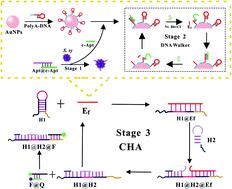Our official English website, www.x-mol.net, welcomes your
feedback! (Note: you will need to create a separate account there.)
An enzyme-mediated universal fluorescent biosensor template for pathogen detection based on a three-dimensional DNA walker and catalyzed hairpin assembly
Nanoscale ( IF 5.8 ) Pub Date : 2020-12-11 , DOI: 10.1039/d0nr07593k Dan Li 1, 2, 3, 4, 5 , Enlai Yang 1, 2, 3, 4, 5 , Zewei Luo 1, 6, 7, 8, 9 , Qiyue Xie 1, 2, 3, 4, 5 , Yixiang Duan 1, 2, 3, 4, 5
Nanoscale ( IF 5.8 ) Pub Date : 2020-12-11 , DOI: 10.1039/d0nr07593k Dan Li 1, 2, 3, 4, 5 , Enlai Yang 1, 2, 3, 4, 5 , Zewei Luo 1, 6, 7, 8, 9 , Qiyue Xie 1, 2, 3, 4, 5 , Yixiang Duan 1, 2, 3, 4, 5
Affiliation

|
An enzyme-mediated universal fluorescent biosensor template for rapid detection of pathogens was developed based on the strategy of a three-dimensional (3D) DNA walker and catalyzed hairpin assembly (CHA) reaction. In the bacterial recognition step, a strand displacement reaction between bacteria and the double-stranded complex caused the release of the walker strand. The walker strand triggered the DNA walker to produce an enzyme fragment, and the DNA walker used gold nanoparticles (AuNPs) as the track to provide an excellent DNA ligand anchoring area. In the CHA step, the enzyme fragment induced the CHA cycle to yield fluorescence signals, which greatly enhanced the conversion ratio of trigger DNA and the sensitivity of the fluorescent biosensor. The effect of the distance and density of the DNA ligand was studied by adjusting the length of poly-adenine (PolyA), and was further explored by its reaction kinetics. By comparing the maximum reaction rate (Vmax), Michaelis constant (Km) and turnover number (Kcat), the optimized PolyA probe was assessed and identified. In this work, the optimized PolyA-DNA probe exhibited an outstanding sensitivity in Salmonella typhimurium (S. ty) detection, which is 11.9 times and 4.6 times higher than those of the SH-DNA and the MCH treated SH-DNA. Meanwhile, a detection limit of 28.1 CFU mL−1 was achieved in Escherichia coli (E. coli) detection. Furthermore, the biosensor achieved good selectivity and high repeatability with recoveries of 91%–115% for real sample detection. Considering these advantages, this template has great potential as a routine tool for pathogen detection and has wide applications in the field of global public health and food safety.
中文翻译:

基于三维DNA Walker和催化发夹装配的用于病原体检测的酶介导的通用荧光生物传感器模板
基于三维(3D)DNA Walker和催化发夹装配(CHA)反应的策略,开发了一种酶介导的通用荧光生物传感器模板,用于快速检测病原体。在细菌识别步骤中,细菌与双链复合物之间的链置换反应引起助步链的释放。沃克链触发了DNA沃克产生酶片段,并且DNA沃克使用金纳米颗粒(AuNPs)作为轨道,以提供出色的DNA配体锚定区域。在CHA步骤中,酶片段诱导CHA循环以产生荧光信号,从而极大地提高了触发DNA的转化率和荧光生物传感器的灵敏度。通过调节聚腺嘌呤(PolyA)的长度来研究DNA配体的距离和密度的影响,并通过其反应动力学进一步对其进行探索。通过比较最大反应速率(V max),米氏常数(K m)和周转数(K cat),评估和鉴定了优化的PolyA探针。在这项工作中,优化的PolyA-DNA探针在鼠伤寒沙门氏菌(S. ty)的检测中表现出出色的灵敏度,分别是SH-DNA和MCH处理的SH-DNA的11.9倍和4.6倍。同时,在大肠杆菌(E. coli)中的检出限达到了28.1 CFU mL -1。)检测。此外,该生物传感器实现了良好的选择性和高重复性,用于真实样品检测的回收率为91%–115%。考虑到这些优点,该模板作为病原体检测的常规工具具有巨大潜力,并且在全球公共卫生和食品安全领域具有广泛的应用。
更新日期:2021-01-20
中文翻译:

基于三维DNA Walker和催化发夹装配的用于病原体检测的酶介导的通用荧光生物传感器模板
基于三维(3D)DNA Walker和催化发夹装配(CHA)反应的策略,开发了一种酶介导的通用荧光生物传感器模板,用于快速检测病原体。在细菌识别步骤中,细菌与双链复合物之间的链置换反应引起助步链的释放。沃克链触发了DNA沃克产生酶片段,并且DNA沃克使用金纳米颗粒(AuNPs)作为轨道,以提供出色的DNA配体锚定区域。在CHA步骤中,酶片段诱导CHA循环以产生荧光信号,从而极大地提高了触发DNA的转化率和荧光生物传感器的灵敏度。通过调节聚腺嘌呤(PolyA)的长度来研究DNA配体的距离和密度的影响,并通过其反应动力学进一步对其进行探索。通过比较最大反应速率(V max),米氏常数(K m)和周转数(K cat),评估和鉴定了优化的PolyA探针。在这项工作中,优化的PolyA-DNA探针在鼠伤寒沙门氏菌(S. ty)的检测中表现出出色的灵敏度,分别是SH-DNA和MCH处理的SH-DNA的11.9倍和4.6倍。同时,在大肠杆菌(E. coli)中的检出限达到了28.1 CFU mL -1。)检测。此外,该生物传感器实现了良好的选择性和高重复性,用于真实样品检测的回收率为91%–115%。考虑到这些优点,该模板作为病原体检测的常规工具具有巨大潜力,并且在全球公共卫生和食品安全领域具有广泛的应用。











































 京公网安备 11010802027423号
京公网安备 11010802027423号